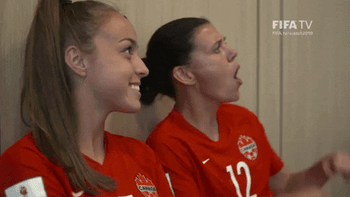⚽️ How it works
The UEFA European Women’s Championship, a mouthful better known as the Women’s Euro, brings together Europe’s top 16 women’s teams — whittled down from 47 — once every four years to duke it out for continental glory.
The tournament consists of two stages: first, the three-game round robin group stage, which splits the 16 teams into four groups (more on them in a bit). The top two teams from each, based on points during the round robin — three for a win, one for a draw — advance to the knockout stage.
- The knockout stage includes the quarter-finals, the semifinals and a final that’s set for July 31st. The last two teams standing will square off at London’s iconic Wembley Stadium in front of a packed house.
As a continental championship featuring some of the best national teams in the world, the Euros are an international BFD, even for us North Americans. So if you don’t have a nation to cheer for yet, here’s “the gist” on every group to help you pick.
🏴🇳🇴🇦🇹🏴 Group A: England, Norway, Austria, Northern Ireland
The favorite: The host nation, England, is the crown jewel of Group A, and possibly the entire tourney. And while they’ve made two Euro final appearances, they’ve yet to hoist the trophy. Maybe the third time — and the hometown crowd — will be the charm?
- But not if Norway has anything to say about it. With Caroline Graham Hansen and friend of The GIST Ada Hegerberg on the front line, there’ll be no shortage of goals from the grasshoppers.
The dark horse: It’ll be tough to top England and Norway, but Austria’s chances rest largely on the shoulders (or feet?) of midfielder Sarah Zadrazil. She can juggle, she can ride a unicycle, and now, she might help her team out of Group A.
The players to watch: The fixtures of England’s offense — forwards Beth Mead and Lauren Hemp. Mead was surprisingly left off England’s Olympic roster, but she’s only let it fuel her, while the 21-year-old Hemp just secured her third straight Professional Footballers’ Association Women’s Young Player of the Year award. The kid is quite alright.
🇩🇪🇪🇸🇩🇰🇫🇮 Group B: Germany, Spain, Denmark, Finland
The favorites: Although they’ll be without the 2021 Ballon d’Or winner, midfielder Alexia Putellas, who tore her ACL earlier this week (talk about bad timing…), Spain boasts five other players featured in ESPN FC’s recent ranking of the world’s 50 best footballers, with three in the top 10.
- Germany, the eight-time Euro champs, could give them a run for their money, especially with midfielder Sara Däbritz, who won the 2016 Olympic gold and the 2019 World Cup with the national team.
KnowledgeExperience is power.
The dark horse: Don’t let their No. 29 world rank fool you — Finland could shake things up in what many are calling the “group of death.” They boast Portland Thorns FC defender Natalia Kuikka and Finland’s all-time leading scorer, Linda Sällström, who netted 10 goals in qualifying rounds. Plenty of sisu in this club.
The player to watch: Pernille Harder, Denmark’s record scorer. A two-time UEFA Women’s Player of the Year, Harder can take over the game with her scoring and passing capability. Especially after Denmark missed out on the 2019 World Cup, expect the captain to step up in a big way.
🇸🇪🇳🇱🇨🇭��🇵🇹 Group C: Netherlands, Sweden, Switzerland, Portugal
The favorites: Sweden. The yellow and blue are a well-oiled machine. Center back Magdalena Eriksson leads the defense, while midfielder Kosovare Asllani is a fixture in the attack. The squad also has a chip on its shoulder, winning Olympic silver in 2016 and 2020. Maybe they’ll be No. 1 this time around without the U.S. and Canada in the mix. *winks*
- Don’t sleep on the Netherlands, though. Yes, the reigning Euro champs have a new coach, but they boast world-class talent, especially up front in Vivianne Miedema and Lieke Martens.
The dark horse: After qualifying for the Euro for the first time in 2017, Switzerland is aiming to establish itself as one of Europe’s emerging teams this time around. Making it to the knockouts might be tough considering the competition, but playing Switzerland won’t be a cakewalk with forward Ana-Maria Crnogorčević on the field.
The player to watch: Miedema. She is undoubtedly one of the world’s best forwards and always delivers. She comes into this year’s Euro in strong form — she was the top scorer at last year’s Olympic Games with 10 goals and scored 23 times for FA WSL team Arsenal last season.
🇫🇷🇮🇹🇧🇪🇮🇸 Group D: France, Italy, Belgium, Iceland
The favorites: France holds the world No. 3 ranking for good reason — the country has no shortage of naturally gifted players. Marie-Antoinette Katoto is a reliable goalscorer, while captain Wendie Renard frequently pairs her defensive strengths with attacking flair. There’s some friction between the athletes and coach, though, which could dent title hopes.
- If anyone’s well poised to become Europe’s next team to watch, it’s Italy. The team has built momentum since a surprise run to the World Cup quarter-finals in 2019, with forward Barbara Bonansea ready to score. Get that chef’s kiss emoji ready.
The dark horse: This year’s Euro marks Belgium’s second appearance at a major tournament, but the team made quite a splash during qualifying, too — forward Tine De Caigny scored a whopping 12 goals in seven qualifying games. Break out the waffles.
The players to watch: Katoto. The young forward has an impressive 24 goals in 29 games for her national team and picked up 32 goals for club team Paris Saint-Germain this season. Prepare to hear the commentators announce her name…a lot.
📺 How to tune in
As mentioned, various cities across jolly ol’ England will play host to the action, which kicks off today and runs through the final on Sunday, July 31st. Americans can tune in on ESPN…sorry to our Canadians, but the tournament isn’t televised in the Great White North.
Enjoying this article? Want more?

Sign up for The GIST and receive the latest sports news straight to your inbox three times a week.


